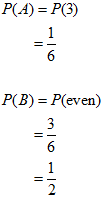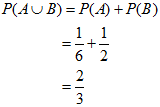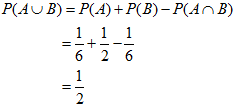Addition of Probabilities
First consider what are joint (or not-mutually exclusive) and disjoint (or mutually exclusive) events.
Suppose S.S = {1, 2, 3, 4, 5, 6}
Then even and odd numbers in the above set are disjoint events. As Even Numbers = 2, 4,6 and Odd Numbers = 1, 3, 5
But, if we are interested in even numbers and multiple of three, then Even Numbers = 2, 4, 6 and Multiple of Three = 3, 6. So, 6 is joint element.
Addition Rule: Disjoint Events

Addition Rule: Joint Events

Remember:

Example 1. A dice is rolled once. What is the probability that the number shown is 3 or even number?
Solution
3 is one event out of total 6 events, and even numbers {2,4,6} are three events out of total six events. Thus their probabilities are

Thus,

Example 2. A dice is rolled once. What is the probability that the number shown is 3 or odd number?
Solution

Now, there is one joint element i.e. 6. So,

Thus,

|
Basic Financial terms in Corporate and Mathematical Finance |
Selection of assets, risk and return, and portfolio analysis |
View the online notes for Financial Mathematics (CT1) |
Learn Financial Computing with C++ step by step |